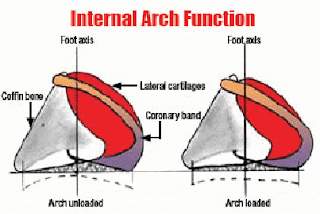Concavity, Conformation or
Health?
By KC La Pierre
We often receive emails from
horse owners exhibiting frustration over their inability to aid their horse in
achieving concavity to their horses' hooves. Usually it is said that their
horse is footie (tender over rough or hard ground) after months or even years
of being barefoot. They go on to explain that they are frustrated, because they
feel that they have been doing all the right things; created a natural
environment, provided exercise, have addressed nutrition and done all of the
other things that are said to achieve concavity and health to the hoof. Why
then is my horse still footie over rough ground and why can't I get concavity!
The first objective when
attempting to answer such an email is to determine the true conformation and
the state of health of their horses' foot. Lack of concavity is not something
that can be corrected by trimming, and a lack of concavity is not always the
cause for a horse being footie (stay with me here). Concavity defines
conformation and not health. Taking a simplistic view of the sole does not
serve the horse. The sole, like the hoof wall cannot be viewed or treated as
homogeneous (having the same make-up throughout). The sole is divided into two
distinct structures, the Primary Sole and the Terminal Sole. Each is defined by
its conformation and the property of its horn (tissue). The Primary Sole is the
horn that has a foundation of bone (that part of the sole that covers the
coffin bone). The Terminal Sole is that which has a foundation of cartilage and
forms around the perimeter of the coffin bone. Being familiar with the
"Hoof Wall Matrix" will help you to determine the current state of
health of both the primary and terminal sole. As the health of the sole
increases a matrix is formed creating a healthy transition from terminal sole
to primary sole. This matrix is important to overall performance.
Terminal sole consist of horn
that is made up of terminal tubules (tough horn that distorts without failure)
and intertubular horn, terminal sole allows for needed distortion. Primary sole
consist of primary tubules (hard horn that provides stability, resisting
distortion) and intertubular horn. The function of each is determined by its
foundation. The chief function of the primary sole is to protect the coffin
bone (its foundation), not from concussion, but rather from torque (twist). The
primary function of the terminal sole is to allow for distortion (also
protecting the coffin bone from torque), and to provide protection from blunt
trauma. In both instances the horn needs to be healthy, have depth, and have a
strong matrix.
Lack of concavity to the primary
sole in truth defines the conformation of its foundation, the coffin bone. It
is not possible to increase this concavity. If there is little concavity to the
distal dorsal (bottom) surface of the coffin bone, there will be little
concavity to the primary sole. The Unified Sole Theory by Mike Salvoldi describes
uniform thickness of the sole. However, concavity of the hoof capsule is not
defined by the concavity of the primary
sole. Concavity of the solar (bottom)
aspect of the hoof does increase with an increase in the depth of horn of both
the primary and terminal sole. Why? Take a look at the illustrations presented
here.
You will see that as the diameter and height of a concave structure
increases the depth of the concavity increases (its center is further from its
perimeter). The concavity (conformation) of the primary (center) sole does not
change, but the conformation of the overall solar aspect does. The internal
foot is in effect further away from the ground surface and better protected by
healthier thicker horn.
Many of the hooves presented with
lack of concavity are in fact exhibiting a lack of depth in solar horn and poor
matrix to both the sole and hoof wall.
Is lack of concavity to the
primary sole a cause for concern? Because function is determined by
conformation and the property of a structure's tissue, a lack of concavity to
the coffin bone can result in a diminished ability to dissipate the energies
created during the stance (load) phase of the stride. Some horses can handle
higher levels of energy and cope well with a flat conformation (within limits),
where others are more sensitive to the energies resulting from a flat
conformation. If your expectation is for high performance where the foot is
exposed to high levels of energy, then conformation of this sort does become a
concern.
How can we help the horse with
such conformation? After all concavity cannot be returned to the coffin bone.
As I mentioned earlier in this article depth of sole can be increased, that is
if the conditions are right. Following two principles of Applied EquinePodiatry can help in developing a treatment protocol that can help in the
development of a stronger hoof capsule (including Sole).
1. Accepting
that the horse does have the natural ability to heal itself, this provided the
environment is conducive to healing.
2. That
correct force is the stimulus for correct growth
Starting with a balanced hoof and exercising within the defined Spectrum of Usability for the horse are paramount to success.
 If you are dealing with less than ideal conformation of the coffin bone do your homework on foot function.
If you are dealing with less than ideal conformation of the coffin bone do your homework on foot function.
It is not possible to increase the concavity of the foundation, but it may be possible to increase the health of those structures that will supplement foot function.
























